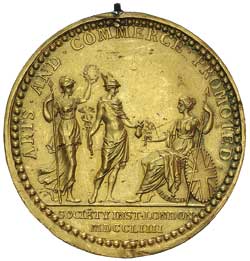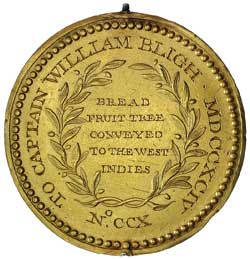Orders, Decorations & Medals - British Singles
Lot 3881 Session 13 (2.30pm Thursday) Orders, Decorations & Medals - British Singles
Estimate $50,000
Bid at live.noble.com.au
SOLD $116,000
SOCIETY FOR THE ENCOURAGEMENT OF ARTS, Manufactures and Commerce Medal 1754, (usually referred to as The Royal Society of Arts), in gold (42.4gm; 44mm) by T.Pingo (MI 684/401; Eimer 648), obverse, Britannia seated left is conferred with honours by Mercury and Minerva standing before her, around top edge, Arts. And. Commerce. Promoted., in exergue, Society Inst. London / MDCCLIIII, reverse, a wreath, inside engraved, 'BREAD / FRUIT TREE / CONVEYED / TO THE WEST / INDIES', around edge, 'TO CAPTAIN WILLIAM BLIGH. MDCCXCIV', at the bottom 'No.CCX'. Pin inserts into rim at 12 and 6 o'clock, probably for a swivel display stand, otherwise good very fine and rare.
The Society for the Encouragement of Arts, Manufactures and Commerce was founded in 1754 by William Shipley. In 1847 it was granted a Royal Charter and in 1908 King Edward VII granted it the right to use Royal. In its formative years the Society offered prizes which it called 'premiums' to anyone who could successfully complete one of a number of challenges it published. One of these related to a desire by Sir Joseph Banks to transplant a major food crop from one part of the world to another. One of the discoveries made during Cook's Third Voyage was breadfruit. When Banks learned of this food he wanted to transport it across the world to the West Indies as a food source for the slave labourers. Bligh's wife was the niece of Duncan Campbell, a merchant and contractor in charge of convict hulks in the Thames. Between 1783 and 1787 Bligh served Campbell in the West Indian trade and when the HMS Bounty was bought from Campbell to lead an expedition to procure breadfruit for the West Indies, William Bligh was appointed commander and purser. The Bounty was only rated as a cutter and hence it had no officers other than Bligh who at the time was a Lieutenant. It had a small crew, and no Marines for protection and to maintain shipboard security. On 28 November 1787 the Bounty set sail for Tahiti. The voyage was difficult and after trying for a month to sail round Cape Horn, the Bounty was incapable of overcoming the notoriously stormy weather and finally had to proceed by the long voyage around the Cape of Good Hope. As a consequence Bligh arrived at Tahiti in 1788, eleven months after his departure and out-of-season for breadfruit. He now had to wait around for several months for the new seeded breadfruit to grow into saplings mature enough for transportation. In hindsight, Bligh then made a decision that would set off a chain of events that would become history making. Instead of using the waiting time of 5-6 months for exploring and mapping in the surrounding area, he gave the crew six months shore leave in a tropical paradise. Many men formed intimate relationships with native women and became very accustomed to the happy-go-lucky, laid back and peaceful existence, an idyllic paradise compared to what they were accustomed on board ship. Consequently, when it was time to leave and transport the breadfruit to the West Indies, many of the men were not happy. Under the leadership of Fletcher Christian, a Master's Mate in charge of one of the ship's watches, the crew mutinied on 28 April 1789, during the return voyage. Eighteen of the crew had seized firearms during Mr Christian's watch and although they were not in the majority, they had the power to suppress the remaining crew, overcome the ship's captain, Lieutenant Bligh, by surprise in his cabin and bind him up. Then they placed Bligh and eighteen of his crew who remained loyal into a seven metre launch armed with only four cutlasses and supplied with enough food and water for a few days, a quadrant and a compass but no charts, sextant or marine chronometer. Four other loyal crewmen could not fit in the launch so they were retained for their useful skills and later released at Tahiti. Then from a seemingly impossible situation, Bligh completed one of the greatest seagoing feats in history by navigating from memory of his charts and guiding this small, overloaded and barely seaworthy vessel on a voyage of about 6,700 kilometres or over 3,600 nautical miles to arrive safely in Timor 47 days later. After his return to London he was subject to court martial in October 1790 for the loss of his ship but he was honourably acquitted. Shortly after, and as an indicator of their support, the Admiralty appointed Bligh to the rank of Captain in November. Meanwhile, Bligh had the full support of Sir Joseph Banks and so at his urging, the Admiralty appointed Bligh as captain of HMS Providence to make a second attempt to transport breadfruit from Tahiti to the West Indies. Thus the Providence in company with another ship, HMS Assistant, set off to complete the mission. During the voyage Bligh also engaged in some charting of the south-east coast of Van Diemen's Land during a stay at Adventure Bay which he had previously visited with Cook and with the Bounty. He also made valuable observations at Fiji, Tahiti and in the Torres Strait although he did have a 'falling out' with one of his midshipmen, Matthew Flinders, who thought Bligh did not give him sufficient credit for his charting. By February 1793 the breadfruit mission had been accomplished. Bligh also took specimens of the ackee fruit (Genus Blighia) of Jamaica to England and introduced it to the Royal Society and provided specimens for the Royal Botanical Garden at Kew. The Genus Blighia, which consists of some four specimens of evergreen tropical shrubs and trees, is named in William Bligh's honour. The most commonly cultivated of these is the Blighia sapida. In recognition of his achievement with the breadfruit transportation, The Royal Society of Arts awarded William Bligh with its Gold Medal, the medal offered in this lot.
Estimate / sale price does not include buyer's premium (currently 22% including GST) which is added to hammer price. All bids are executed on the understanding that the Terms & Conditions of sale have been read and accepted. For information on grading and estimates please refer to the Buying at Auction advice.
Quick find
View a lot by number and sale.
Adjacent lots
Lot 3879
KING'S POLICE AND FIRE SERVICES MEDAL (GVIR) FOR GALLANTRY, 1st type. 250 Sgt Zeidi Ramadan ...
Estimate $1,250
Lot 3880
NAVAL GOLD MEDAL 1795, small size (33mm) as awarded to ship Captains, in fitted gold ...
Estimate $200,000
Lot 3881
SOCIETY FOR THE ENCOURAGEMENT OF ARTS, Manufactures and Commerce Medal 1754, (usually referred to as ...
Estimate $50,000
Lot 3882
SET OF SIX STERLING SILVER FIDDLEBACK FORKS, London, hallmarked 1802, maker CB/TB (Christopher & Thomas ...
Estimate $3,000
Lot 3883
NAVAL GENERAL SERVICE MEDAL 1793-1840, - clasp - Syria. Michael Bresneken. Impressed. Extremely fine.
Estimate $600

